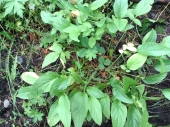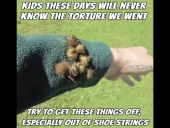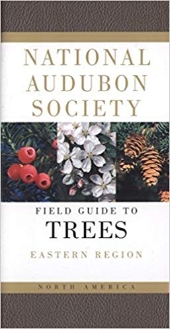
 2
2




"Them that don't know him don't like him and them that do sometimes don't know how to take him, he ain't wrong he's just different and his pride won't let him do the things to make you think he's right" - Ed Bruce (via Waylon and WIllie)





There is nothing so bad that politics cannot make it worse. - Thomas Sowell
Everything that is really great and inspiring is created by the individual who can labor in freedom. - Albert Einstein




Kristine Keeney wrote:To be honest? There are a few local to me wild plants that have similar growth habits. They start off with a basal "plate" looking like something, then they seriously put on the growth and the differences emerge.
I'm tempted to say it looks like what I used to call "Texas Dandelion" which is similar in habit and develops annoying little prickles on leaf midribs and the stem. (The plant is also called "Prickly Lettuce" according to the Internet. Lactuca serriola sp.)
https://www.weedimages.org/browse/subthumb.cfm?sub=5918
"Them that don't know him don't like him and them that do sometimes don't know how to take him, he ain't wrong he's just different and his pride won't let him do the things to make you think he's right" - Ed Bruce (via Waylon and WIllie)




Invasive plants are Earth's way of insisting we notice her medicines. Stephen Herrod Buhner
Everyone learns what works by learning what doesn't work. Stephen Herrod Buhner




Anne Miller wrote:Are the leaves prickly where you can't pull the plant without getting stuck by the prickles?
My guess would be when it blooms it is sow thistle. Which is the plant taking over my patio this year.
I am not sure how to tell the difference between prickly lettuce or sow thistle.
https://en.wikipedia.org/wiki/Sow_thistle
"Them that don't know him don't like him and them that do sometimes don't know how to take him, he ain't wrong he's just different and his pride won't let him do the things to make you think he's right" - Ed Bruce (via Waylon and WIllie)




“O frischer Duft, o neuer Klang! Nun, armes Herze, sei nicht bang!
Nun muss sich Alles, Alles wenden.”




Jennifer Kowalski wrote:Might be a sisymbrium of some sort - tumble mustard or false London rocket maybe? What region are you located in?
Sisymbrium Wikipedia
"Them that don't know him don't like him and them that do sometimes don't know how to take him, he ain't wrong he's just different and his pride won't let him do the things to make you think he's right" - Ed Bruce (via Waylon and WIllie)




![Filename: C41A0F99-6D08-4209-90A2-68F06292106A.jpeg
Description: [Thumbnail for C41A0F99-6D08-4209-90A2-68F06292106A.jpeg]](/t/159433/a/138395/C41A0F99-6D08-4209-90A2-68F06292106A.jpeg)
“O frischer Duft, o neuer Klang! Nun, armes Herze, sei nicht bang!
Nun muss sich Alles, Alles wenden.”
 1
1




Jennifer Kowalski wrote:This guy had a similar-looking s. loeselli plant - his “mid-April” shot is from a bit further along, but shows a lot of those leaf features.
http://www.robsplants.com/plants/SisymLoese
"Them that don't know him don't like him and them that do sometimes don't know how to take him, he ain't wrong he's just different and his pride won't let him do the things to make you think he's right" - Ed Bruce (via Waylon and WIllie)




Invasive plants are Earth's way of insisting we notice her medicines. Stephen Herrod Buhner
Everyone learns what works by learning what doesn't work. Stephen Herrod Buhner
 1
1




I'm only 65! That's not to old to learn to be a permie, right?




"Them that don't know him don't like him and them that do sometimes don't know how to take him, he ain't wrong he's just different and his pride won't let him do the things to make you think he's right" - Ed Bruce (via Waylon and WIllie)
 1
1




"Them that don't know him don't like him and them that do sometimes don't know how to take him, he ain't wrong he's just different and his pride won't let him do the things to make you think he's right" - Ed Bruce (via Waylon and WIllie)

|
I am going down to the lab. Do NOT let anyone in. Not even this tiny ad:
The new permaculture playing cards kickstarter is now live!
https://www.kickstarter.com/projects/paulwheaton/garden-cards
|






